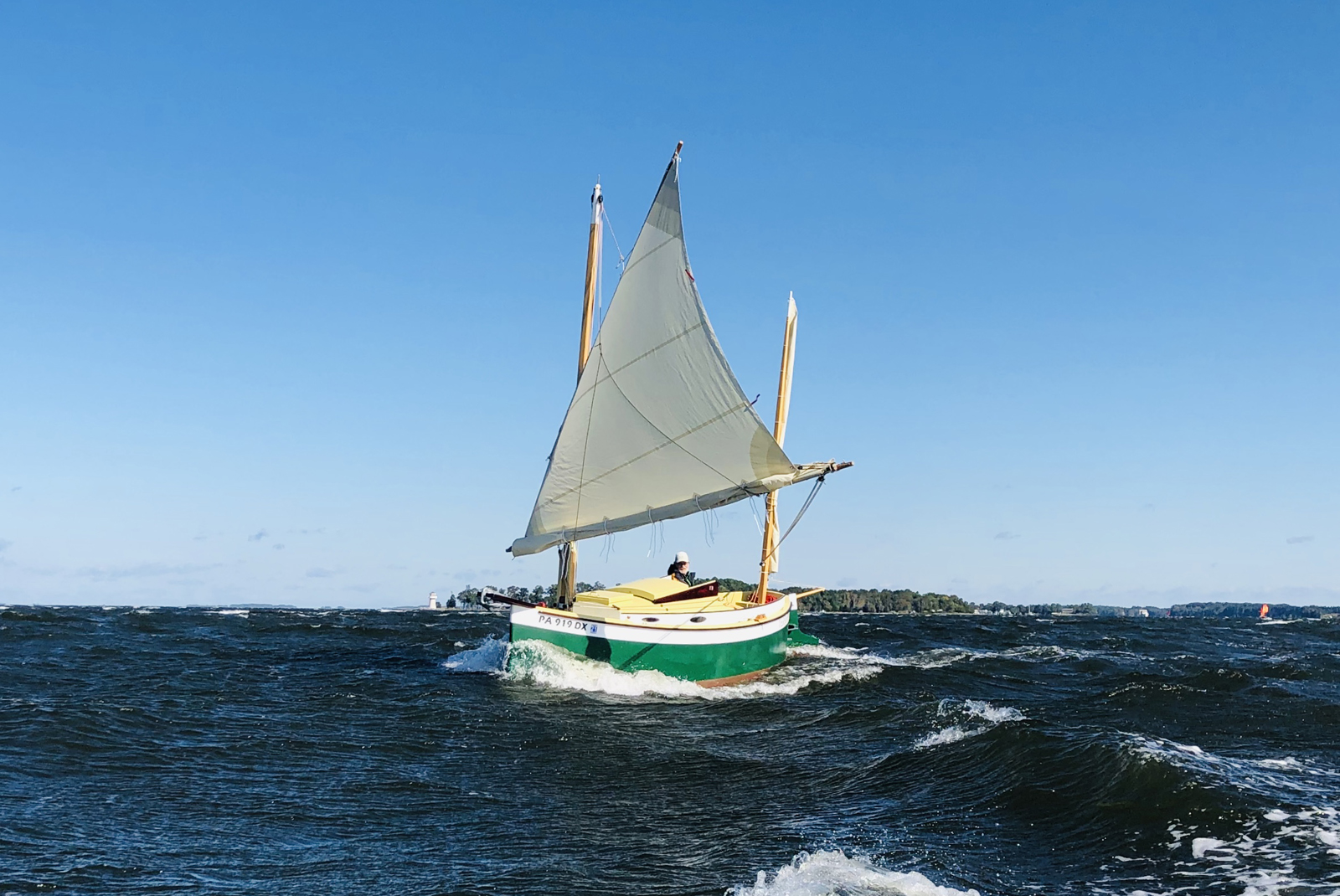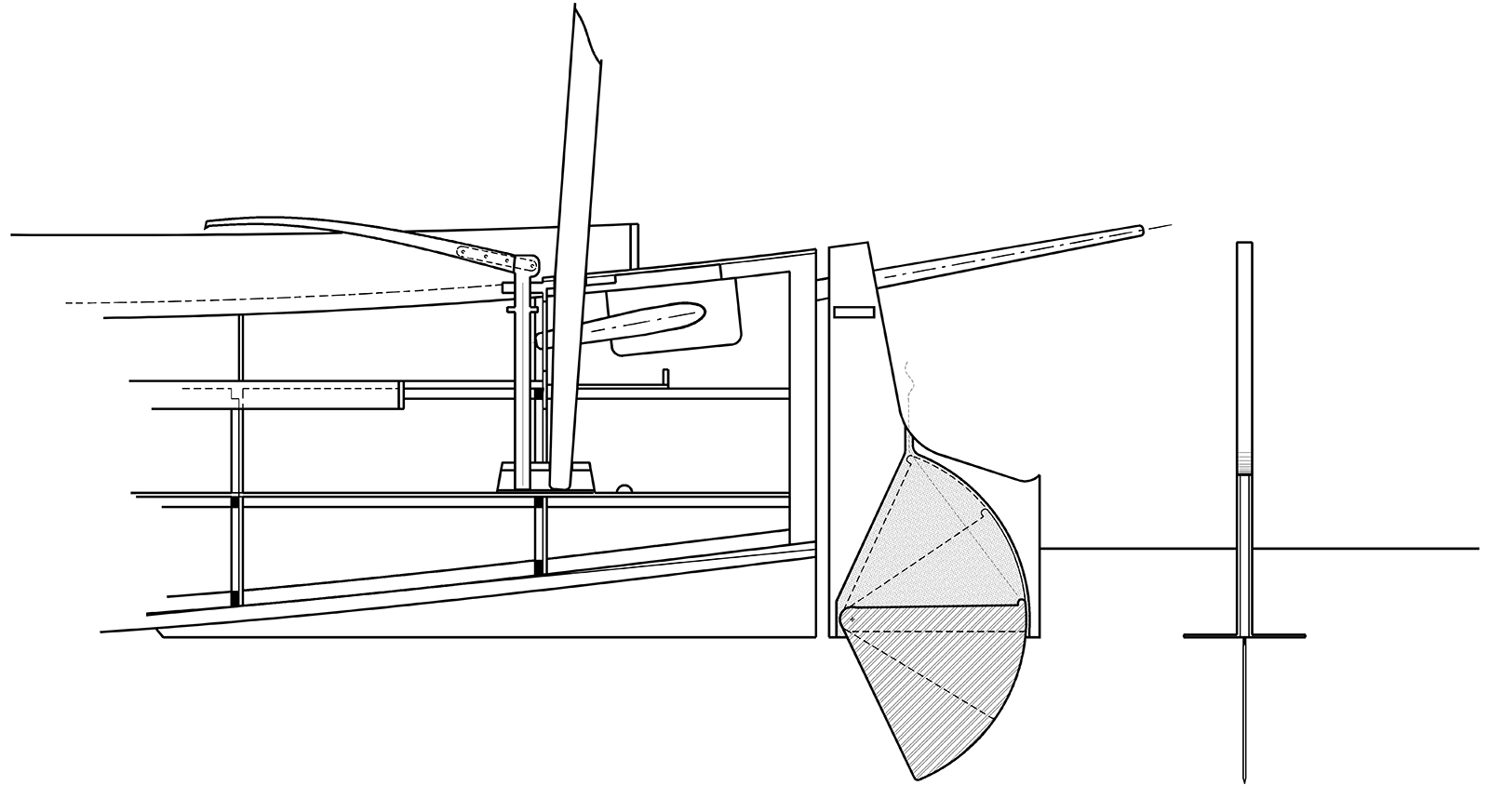Encore, Autumn Leaves: The Canoe Yawl Sails
October 2019

Interesting things happen when there is no profit motive. Unusual boats get built, and checking accounts dwindle. Having been resigned to the latter as long as I've had a checking account, I've been lucky to enjoy a good bit of the former. Autumn Leaves is one such lark, and a few weeks ago I had the pleasure of seeing one foaming along in a fine October breeze.
For lots of sailing photos, see the gallery here. For some good sailing action video, click here. In 2022, I posted notes and a comparison of the jib-headed and lug-rigged versions. (Quite technical.)
A detailed design study of Autumn Leaves appears in this 2016 blog post, as well as in articles in WoodenBoat and Small Craft Advisor magazines. To recap, Autumn Leaves belongs to the genus "canoe yawl." This is a subset of sailing pocket cruiser popularized in the years between about 1880 and 1920 by Victorian yachties including Albert Strange and George Holmes. Much admired for their beauty and grace under sail, canoe yawls are commercially extinct because they have modest accommodations, usually lack an engine, and are expensive and complex to build. Not a winning combination in 2019.
For years I've been trying to simplify the construction of a classic canoe yawl without losing the essential character of the originals. Those character traits include a combination of heavy displacement and sleek hull lines. This tricky alchemy results in sailboats that are capable in ugly weather, yet are still fleet and agile enough to sail in and out of tricky spots without recourse to an engine.
I knew I'd never have such a boat myself if it wasn't quick and easy to build. My hero Phil Bolger spent a lot of unbilled hours dreaming up neo-canoe yawls that were accessible to the common weal; Dovekie, Birdwatcher, and Anhinga are some examples. I'd owned a Dovekie, sailed in a Birdwatcher, and built a model of Anhinga, but I'm greedy. I wanted all that plus a nicer cabin and more emphatic upwind performance.
Months of trying to replicate Albert Strange's Cherub II design in computer-cut plywood ended in frustration. My attempts seemed to retain the worst traits of that design (expensive and difficult to build) while losing its delights (great beauty and sailing qualities).
Out came a clean sheet of paper. I'd had a start about 10 years ago in sketching a double-ender called Pocket Change, supposedly a quick-building alternative to the refined and sophisticated PocketShip. It was no more than that, a sketch, but it got loose on the internet and excited some comment. I think Pocket Change needed more cowbell and I never finished the design. Given a longer, slimmer hull and a nicely-proportioned deck house, Pocket Change's plumb-sided sharpie hull started to work, and became Autumn Leaves. A generous amount of lead ballast keeps her rightside-up and make her less likely to skate out from under you, as Dovekie, Birdwatcher, and Anhinga can.
Update: as of 2022, we've captured photos of two examples in the wild. Here's the latest on Autumn Leaves.
 |
| Al Stead's Autumn Leaves under construction. |
 |
| Dave Dawson's Autumn Leaves under construction. |
Al Stead of Minnesota was the first to the finish line, building his Autumn Leaves from plans. He's yet to get in any sailing but the boat looks great.
David Dawson built his from a CLC kit, named it Terrapin, and had some exciting shakedown cruising at the 2019 Mid Atlantic Small Craft Festival a few weeks ago. I was lucky to be on hand; Dave is an accomplished sailor and craftsman, which made the experience especially gratifying for me.
Dave had persuaded me to draw him a balanced lug rig with a mainmast mounted in a tabernacle, replacing the specified jib-headed rig. It made sense to me, being in character with the historical canoe yawls and having simpler rigging. Moving the mast forward allowed a longer coach roof, which certainly didn't harm the boat's looks and adds room below.
 |
| The lug-rigged version of Autumn Leaves, with an unstayed mast in a welded aluminum tabernacle. Notice the slightly longer coach roof. |
 |
| The original jib-headed rig. I like the lug rig but I still like this layout, too. |
The first impression upon stepping aboard is that Autumn Leaves has more stability than you'd think. Both on paper and in life, she looks every bit the canoe, skinny as an eel and easily driven. With 525lbs of lead in the bilges amidships she's pretty stiff. It's like having three average adults laying in the bottom of the boat. I'd done my sums and intended it to be thus, but it was awfully nice to find you could walk anywhere on her decks without the boat falling over.
 |
| Dave Dawson's Terrapin cruising in company with PocketShip #1. In spite of the difference in beam, they both feel about equally stable. |
The layout of the cockpit and cabin is about as I'd imagined it in hours and hours of sketching and cardboard mock-ups in the shop. Settling into the aft-facing sling-seat in the cabin, the interior volume feels luxurious. I'd be very happy there for days or weeks at a time.
 |
| CLC designer Jay Hockenberry tries out the "throne" in Autumn Leaves's interior. Very comfy. |
Dave says he's daysailed as many as four adults. My impression is that while under way, two adults are plenty. One of Dave's thoughtful additions was a nice wide sill at the bottom of the companionway, a great place for a passenger to sit. Lounging down in the cabin seat while under sail was also delightful, and good for the boat's stability.
The first time I encountered Dave and Terrapin under sail, we were both broad-reaching back to St. Michael's after an overnight cruise to Wye Island. I was sailing PocketShip. It was blowing squirrels out of trees, a steady 20 knots with gusts up to 30. In smooth water on the Wye River, it took me an hour to catch Terrapin, even as PocketShip was carrying main and jib and Dave was wearing storm canvas: two reefs in the mainsail and the mizzen furled. Terrapin is a slippery thing!
 |
| Terrapin flying downwind on Eastern Bay. |
 |
| As hard as it's blowing, Dave's sitting...on the lee side of the boat, much to the designer's surprise! |
We crossed a bar at the mouth of the Wye and cruised into Eastern Bay and a wicked three-to-four-foot chop. We got close enough that I was able to grab some photos and videos of Terrapin with my iPhone. I noticed that he was carrying quite a lot of weather helm, which I wasn't expecting in a sailing canoe. The 15-foot long boom on the big lug sail was clearly trying to pull her stern around. The shoal rudder with an endplate follows a pattern I've used over and over again in boats this size, but in these conditions it was almost overmatched. She'd kick her stern out of the water in the short seas, and for a moment try to round up.
 |
| At full boil and crossing the bar at the mouth of the Wye River. |
Dave and I spent a lot of time talking about the rudder and concluded that it was a rare combination of conditions---sailing with that long boom squared out in a half-gale, with a wave period just right to lift her stern from time to time and reduce the rudder's grip. A rare combination, but it'll happen again. We talked of adding a retractable blade inside the stock rudder. Such a thing would be unnecessary and even undesirable 98% of the time, but Autumn Leaves is supposed to be a serious little cruiser so it bears discussion.
The balanced lug mainsail and mizzen combination has almost exactly the same square footage as the original jib-headed rig, and the centers of effort are identical. My reflection on the wild run down Eastern Bay was that with the original jib-headed rig, I'd have had a couple of reefs in the mainsail, and the jib poled out on the other side. This would have eased the helm, and if I start building my own Autumn Leaves tomorrow I don't think I'd modify the rudder. You're welcome to observe that the jib-headed setup requires another $1000 in hardware and line compared to Dave's balanced lug...
Later, I got to take the helm for a nice long sail in more moderate conditions. You do have to mind the mainsheet in the big puffs, but overall the experience was relaxing and fun. She goes where she looks, doesn't hang up in tacking, and feels solid. Like every yawl I've ever driven, the mizzen acts like a big trim-tab. Fiddle with the mizzen sheet and she'll almost self-steer. Offwind, the mizzen contributes noticeably to the drive.
 |
|
Making knots in milder conditions. |
 |
| Fun to sail. The companionway is a fine spot for a passenger. |
 |
|
Skinny, but here she is sailing upright in 12-15 knots of wind. |
 |
| The happy designer in Terrapin's cockpit. |
Autumn Leaves passes the ultimate test, which is that I now want one for myself!


 return to section:
return to section: 












